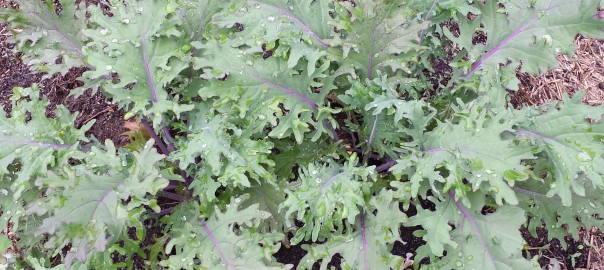Even though the days are a lot shorter and certainly quite a bit cooler, several crops flourish in this environment. Those crops that love and embrace the cooler temps are the dark green leafy vegetables that are so critical for optimal health. Spinach reigned supreme in this category for years, but recently Kale has become tremendously popular and widely available at both local farmer’s markets as well as conventional grocery stores. Even with its rise in popularity , I have found that many people are still unsure what the different types are and how they should be used. This is important because not all types of Kale are the same and might not work for every kale recipe you find. In fact many Kale recipes I have searched online leave out what type of kale is best suited for it. This often leads to people being turned off by kale saying it was too tough or bitter when really that particular type should never have been used.
There are 3 main categories of kale and within each of these there are several varieties. The specific varieties are not as important and pertain more to growing environments, certain types simply grow better in specific areas. There are also some heirloom varieties which may have a bit different flavor or coloring , but the differences are not significant.
The 3 major types of Kale are :
Red Russian: (pictured above) this is the broad leaf kale that has frilled edges but the leaves are primarily flat. This Kale is ideal for salads and require no “massaging” which has always struck me as ridiculous. Red or White Russian or Siberian Kale is mild in flavor and texture so this is the best Kale for all RAW recipes, including smoothies. Simply remove the tough ribs by sliding a knife down the length of the stem and use the rest of the leaves for those delicious salads and raw dishes.
Lacinato, Tuscan or Dino: this is the kale with the bumpy long oval leaves. This is without a doubt my preferred choice for kale chips. You can use this kale raw and in salads, but if you do, I recommend laying the leaves in a stack and slicing them into shreds which helps to relieve some of the inherent toughness in the leaves. This is a great choice for sauteing because it does not shrink as much as red russian kale, which much like spinach reduces in volume by about 70% when cooked.
Winterbore or Curly Squash: please don’t confuse these varieties with the decorative kale you can find at any nursery center though they do look quite the same. This is probably the most common type of kale available and when purchasing frozen kale this is almost always what you get. Curly kale is best for cooking, especially in soups and stews. The hardy leaves stand up to simmering in a pot for hours so if you are making a batch of Portugeuse Kale soup this is definitely the type you want to use. Again you will want to remove the thick rib before cooking because even simmering in a soup for hours these ribs stay tough and hard to chew and can easily turn someone off to kale.
Of course it wouldn’t be an Optimal Kitchen blog with a recipe so here is one for a classic:
PORTUGE– USE KALE SOUP
½ cup chopped celery
½ cup chopped carrots
½ cup chopped onion
1 tbs. chopped garlic
1 bunch curly Kale ( or a 16 oz bag of frozen chopped)
½ small cabbage
4 red potatoes
1lb Linguica or Chorizo
1 15oz. can kidney beans
½ tbs. dried oregano
2 quarts chicken/vegetable broth
Olive oil for cooking
Season with salt and pepper
- Saute onions, carrots, celery and garlic in oil until onions are clear
- Add cut up linguica and cook together over a low heat for 10 mins.
- Add chicken and beef broth and bring to a boil
- Add chopped kale and cabbage
- Reduce heat and simmer for about 1 hour
- Add diced potatoes and beans and simmer until potatoes are tender
I have made this recipe vegetarian and omitted the sausage and it was a delicious soup, but I wouldn’t feel right calling it Portuguese Kale Soup since the addition of Linguica or Chorizo is key to maintaining the ethnicity of this soup!

Comments are closed